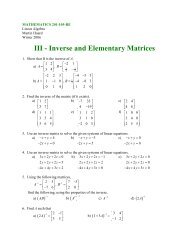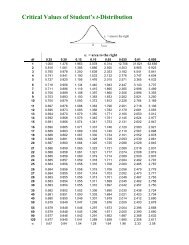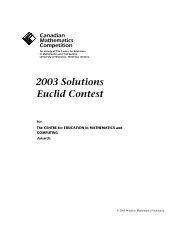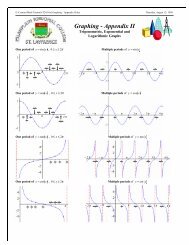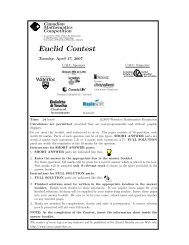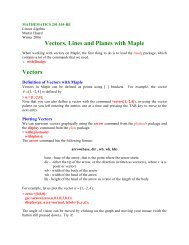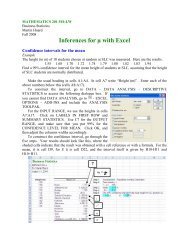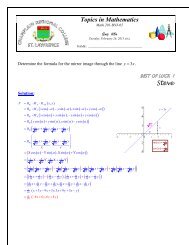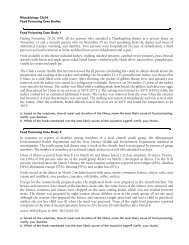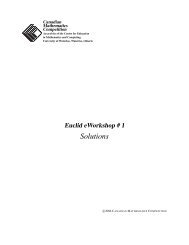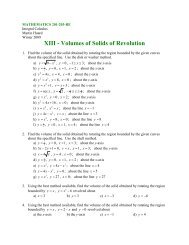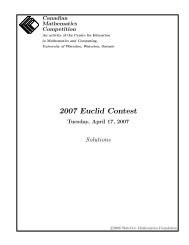XVII - Hypothesis Testing for the mean - SLC Home Page
XVII - Hypothesis Testing for the mean - SLC Home Page
XVII - Hypothesis Testing for the mean - SLC Home Page
Create successful ePaper yourself
Turn your PDF publications into a flip-book with our unique Google optimized e-Paper software.
MATHEMATICS 201-510-LW<br />
Business Statistics<br />
Martin Huard<br />
Fall 2008<br />
<strong>XVII</strong> – <strong>Hypo<strong>the</strong>sis</strong> <strong>Testing</strong> <strong>for</strong> µ (large samples)<br />
1. Write <strong>the</strong> null and alternative hypo<strong>the</strong>ses <strong>for</strong> each of <strong>the</strong> following examples. Determine if<br />
each is a case of a two-tailed, a left-tailed, or a right-tailed test.<br />
a) To test whe<strong>the</strong>r or not <strong>the</strong> <strong>mean</strong> price of houses in Quebec is greater than $143000.<br />
b) To test if <strong>the</strong> <strong>mean</strong> number of hours spent working per week by college students who<br />
hold jobs is different from 15 hours.<br />
c) To test whe<strong>the</strong>r <strong>the</strong> <strong>mean</strong> life of a particular brand of auto batteries is less than 45<br />
months.<br />
d) To test if <strong>the</strong> <strong>mean</strong> amount of time spent doing homework by all fourth-graders is<br />
different from 5 hours a week.<br />
e) To test if <strong>the</strong> <strong>mean</strong> age of all college students is different from 18 years.<br />
2. Consider H : 20<br />
0<br />
µ = versus H<br />
A<br />
: µ < 20<br />
a) What type of error would you make if <strong>the</strong> null hypo<strong>the</strong>sis is actually false and you fail<br />
to reject it<br />
b) What type of error would you make if <strong>the</strong> null hypo<strong>the</strong>sis is actually true and you<br />
reject it<br />
3. According to a Pharmacist, Quebecers spent an average of $220 per person on prescription<br />
drugs in 2006. A recent survey of 300 randomly chosen Quebecers showed that <strong>the</strong>y spent<br />
an average of $235 per person on prescription drugs with a standard deviation of $90. Test at<br />
<strong>the</strong> 2.5% significance level whe<strong>the</strong>r <strong>the</strong> <strong>mean</strong> amount currently spent on prescription drugs<br />
by all Quebecers exceeds $220 per person. Use <strong>the</strong> classical approach.<br />
4. According to Statistics Canada, <strong>the</strong> average family income in Canada was $76 100 in 2004.<br />
A recently taken sample of 1200 Canadian families yielded a <strong>mean</strong> income of $77 152 with a<br />
sample standard deviation of $16 850. Using <strong>the</strong> 2% significance level, can you conclude<br />
that <strong>the</strong> <strong>mean</strong> family income in Canada has changed since 2004 Use <strong>the</strong> classical approach.<br />
5. A study conducted a few years ago claims that adult males spend an average of 11 hours a<br />
week watching sports on television. A recent sample of 100 adult males showed that <strong>the</strong><br />
<strong>mean</strong> time <strong>the</strong>y spend per week watching television is 9.50 hours with a standard deviation of<br />
2.2 hours. Test at <strong>the</strong> 1% significance level if currently all adult males spend less than 11<br />
hours watching sports on television. Use <strong>the</strong> classical approach.
Math 510<br />
<strong>XVII</strong> – <strong>Hypo<strong>the</strong>sis</strong> testing <strong>for</strong> µ (large samples)<br />
6. A telephone company claims that <strong>the</strong> <strong>mean</strong> duration of all long-distance phone calls made by<br />
its residential customers is 10 minutes. A random of 100 long-distance calls made by its<br />
residential customers taken from <strong>the</strong> records of this company showed that <strong>the</strong> <strong>mean</strong> duration<br />
of calls <strong>for</strong> this sample is 9.0 minutes with a standard deviation of 5.2 minutes. Test <strong>the</strong><br />
whe<strong>the</strong>r <strong>the</strong> <strong>mean</strong> duration of all long-distance calls is less than 10 minutes<br />
(a) at <strong>the</strong> 2% level of significance<br />
(b) at <strong>the</strong> 5% level of significance<br />
Use <strong>the</strong> p-value approach.<br />
7. For a population of humans to sustain itself, <strong>the</strong>re must be an average of just of over two<br />
births <strong>for</strong> each woman of reproductive age. The fertility rate varies substantially from within<br />
one nation to <strong>the</strong> next. A journalist recently pointed out in Fortune magazine that <strong>the</strong><br />
average <strong>for</strong> Japan has dropped to 1.5 births <strong>for</strong> each woman of reproductive age, which could<br />
reduce Japan’s population from 135 million in 1997 to 50 million by <strong>the</strong> end of <strong>the</strong> 21 st<br />
century. Suppose a random sample of 200 Japanese women of reproductive age is taken in<br />
2002, and <strong>the</strong> sample <strong>mean</strong> fertility rate is measured as 1.45 with a standard deviation of<br />
0.75. Did <strong>the</strong> rate decline Use a 5% level of significance, with<br />
a) <strong>the</strong> classical approach<br />
b) <strong>the</strong> p-value approach<br />
8. A politician claims that <strong>the</strong> <strong>mean</strong> number of hours Canadians worked per week in a typical<br />
week is greater than 40 hours. A sample of 324 Canadians workers produced a <strong>mean</strong> of 41.3<br />
hours per week with a standard deviation of 10.63 hours per week. Test <strong>the</strong> politician’s<br />
claim at <strong>the</strong> 5% level of significance using<br />
a) <strong>the</strong> classical approach<br />
b) <strong>the</strong> p-value approach<br />
9. The customers at a bank complained about long lines and <strong>the</strong> time <strong>the</strong>y had to spend waiting<br />
<strong>for</strong> service. It is known that <strong>the</strong> customers at this bank had to wait 8 minutes, on average,<br />
be<strong>for</strong>e being served. The management made some changes to reduce <strong>the</strong> waiting time <strong>for</strong> its<br />
customers. A sample of 32 customers taken after <strong>the</strong>se changes were made produced a <strong>mean</strong><br />
waiting time of 7.4 minutes with a standard deviation of 2.1 minutes. Using this sample<br />
<strong>mean</strong>, <strong>the</strong> bank manager displayed a huge banner inside <strong>the</strong> bank mentioning that <strong>the</strong> <strong>mean</strong><br />
waiting time <strong>for</strong> customer has been reduced by new changes. Do you think <strong>the</strong> manager’s<br />
claim is justifiable Use a 2.5% level of significance along with <strong>the</strong> classical approach.<br />
10. A sample of 225 parents were asked how much time <strong>the</strong>y spent per week on school work or<br />
school-related activities. This sample produced a <strong>mean</strong> of 5.6 hours per week, with a<br />
standard deviation of 4.4 hours. At <strong>the</strong> 0.01 level of significance, test <strong>the</strong> claim that <strong>the</strong> <strong>mean</strong><br />
number of hours spent by parents on school work or school-related activities is 5 hours per<br />
week, using<br />
a) <strong>the</strong> classical approach<br />
b) <strong>the</strong> p-value approach<br />
Fall 2008 Martin Huard 2
Math 510<br />
<strong>XVII</strong> – <strong>Hypo<strong>the</strong>sis</strong> testing <strong>for</strong> µ (large samples)<br />
ANSWERS<br />
1. a) H : $143000<br />
0<br />
µ =<br />
H<br />
A<br />
: µ > $143000<br />
c) H0 : µ = 45 months<br />
H : µ < 45 months<br />
A<br />
e) H0 : µ = 18 years Two-tailed<br />
H<br />
A<br />
: µ ≠ 18 years<br />
2. a) Type II error b) Type I error<br />
3. H : $220<br />
0<br />
µ = critical value: z = 1.96<br />
H<br />
A<br />
: µ > $220<br />
4. H0 : µ = $76 100<br />
H : µ ≠ $76 100<br />
A<br />
5. H0 : µ = 11 hours<br />
H : µ < 11 hours<br />
A<br />
6. H0 : µ = 10 minutes<br />
H : µ < 10 minutes<br />
A<br />
A<br />
Right-tailed b) H0 : µ = 15 hours<br />
H : µ ≠ 15 hours<br />
Left-tailed d) H : 5 hours<br />
0<br />
µ =<br />
0.025<br />
test statistic: z = 2.89<br />
critical values: ± z = ± 2.33<br />
0.01<br />
test statistic: z = 2.16<br />
critical value: − z = −2.33<br />
0.025<br />
test statistic: z = −6.82<br />
H<br />
A<br />
A<br />
Two-tailed<br />
Two-tailed<br />
: µ ≠ 5 hours<br />
Reject H 0<br />
Fail to reject H 0<br />
Reject H 0<br />
test statistic: z = −1.92<br />
a) Fail to reject H<br />
p − value = 0.0274<br />
b) Reject H<br />
7. H0 : µ = 1.5 births critical value: − z0.05<br />
= −1.65<br />
Fail to reject H 0<br />
H<br />
A<br />
: µ < 1.5 births test statistic: z = −0.94<br />
p − value = 0.1736<br />
8. H0 : µ = 40 hours critical value: z0.05<br />
= 1.65<br />
Reject H 0<br />
H : µ > 40 hours test statistic: z = 2.20<br />
p − value = 0.0139<br />
9. H : 8 minutes<br />
0<br />
µ =<br />
critical value: − z = −1.96<br />
H<br />
A<br />
: µ < 8 minutes<br />
10. H : 5 hours<br />
0<br />
µ =<br />
H<br />
A<br />
: µ ≠ 5 hours<br />
0.025<br />
test statistic: z = −1.62<br />
critical values: ± z = ± 2.58<br />
0.005<br />
test statistic: z = 2.05<br />
p − value = 0.0404<br />
Fail to reject H 0<br />
Fail to reject H 0<br />
o<br />
o<br />
Fall 2008 Martin Huard 3



